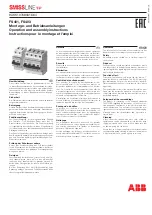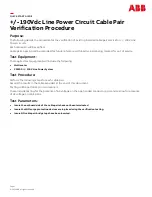
IB 6.2.11.1-1C
Page 7
ABB
located in the lower-rear portion of EO circuit breakers,
and controls the electrical closing functions of the
breaker. The “anti-pump” feature of the SSCD
prevents a second electrical closing until the first
closing signal is released. For example, if the breaker
is closed electrically and the signal is maintained, the
SSCD will not permit the breaker to be closed
electrically again after a trip until the electrical close
signal is released.
Shunt Trip
- The shunt trip is standard on EO breakers
and optional on MO breakers. When energized, it
releases the stored energy of the opening springs
causing the circuit breaker to open.
Closing Spring Charging Motor
- When the motor
disconnect switch is ON, the charging motor is
energized automatically by internal limit switches to
charge the closing springs electrically.
Closing Spring Check Switch (CSCS)
- The CSCS
automatically disconnects the power to the charging
motor when the closing springs are fully charged.
Integral Auxiliary Switch
- The integral circuit breaker
mounted auxiliary switch is standard on EO breakers
and MO breakers with shunt trip, and optional on MO
breakers without shunt trip. The standard configuration
contains the four "a" and four "b" contacts (with three
“a” and two “b” contacts available for customer use via
the secondary disconnects). The switch is
mechanically interconnected with the circuit breaker
mechanism such that, with the circuit breaker closed,
the “a" contacts are closed and the "b" contacts are
open. With the circuit breaker open, the "a" and "b"
contacts reverse positions. This switch is located in the
lower left portion of the circuit breaker.
Optionally, EO breakers and MO breakers with shunt
trip can be fitted with a 16-pole switch, which offers an
additional four each “a” and “b” contacts for customer
use.
Undervoltage Trip Device (Optional)
- The electrically
reset undervoltage trip device (UVD) is a single-phase
device which automatically trips the circuit breaker
when the line voltage decreases to 30 to 60 percent of
the rated voltage. This device is presently only
available for instantaneous trip operation. The
undervoltage trip device is an integral unit which may
be added to the circuit breaker either at the factory or in
the field.
When the breaker is tripped by the UVD, the Automatic
Trip Indicator will extend through the front plate of the
breaker escutcheon. The indicator cannot be reset
until the UVD is electrically reset by the control power.
See Figure 3 for electrical characteristics of the UVD.
Figure 2 - Electrical Characteristics of Control Devices
Nominal Control
Voltage
Average
Charging
Motor
Current*
Shunt Trip or
Close Coil
Current
Closing
Circuit
Voltage
Range
Shunt Trip
Circuit
Voltage
Range
Recommended
Control Fuse Size
120VAC (60 Hz)
10A
6.5A
104-127
104-127
10A
240VAC (60 Hz)
5A
1.2A
208-254
208-254
10A
48VDC
25A
3.1A
38-56
28-56
15A
125VDC
10A
1.3A
100-140
70-140
10A
250VDC
5A
0.7A
200-280
140-280
10A
* Approximate steady state values; momentary in-rush currents are approximately 6-8 times these values
Figure 3 - Undervoltage Trip Device
Operating Data
Service Voltage
Current at
Rated
Voltage
Maximum
Pickup
Voltage
Dropout
Voltage
Range
120VAC (60 Hz)
0.5A
102 36-72
240VAC (60 Hz)
0.2A
204 72-144
480VAC (60 Hz)
0.1A
408 144-288
48VDC
0.3A
41 15-29
125VDC
0.2A
106 38-75
250VDC
0.1A
212 75-150








































